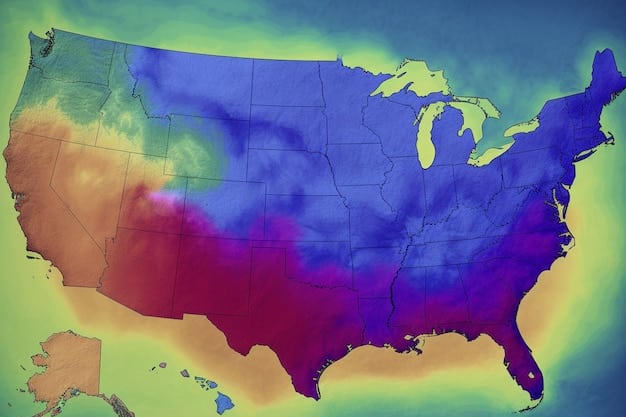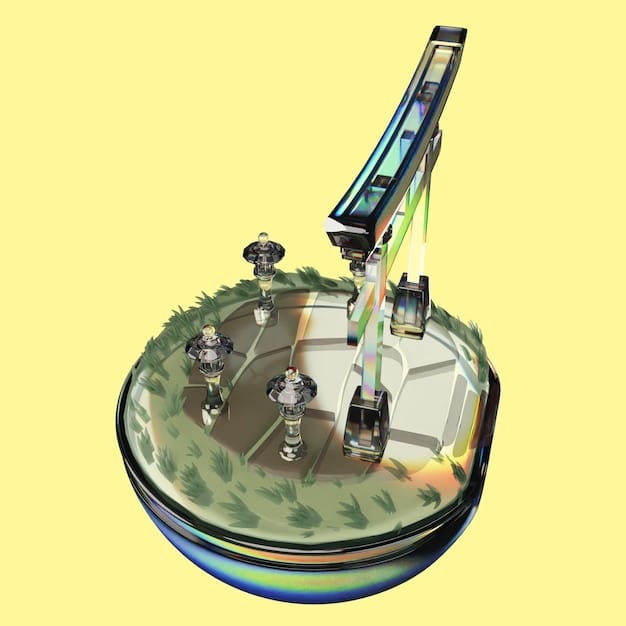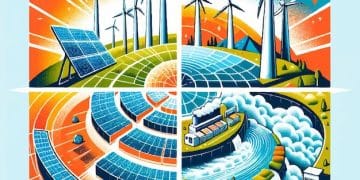Geothermal Energy’s US Potential: Sustainable Future?

Advertisements
The United States holds significant, often untapped, potential for geothermal energy, offering a consistent, low-carbon, and domestically sourced power alternative crucial for decarbonizing its energy grid and bolstering energy independence.
Advertisements
In a world increasingly driven by the imperative of decarbonization and the quest for energy independence, Exploring the Potential of Geothermal Energy: A Sustainable and Renewable Energy Source for the US? emerges as a topic of paramount importance. This often-overlooked power source, deeply rooted beneath our feet, offers a compelling promise for a truly sustainable and resilient energy future. What opportunities does it present for the United States?
Understanding Geothermal Energy: The Earth’s Hidden Heat
Geothermal energy harnesses the natural heat within the Earth’s crust. This heat originates from the decay of radioactive isotopes and residual heat from the planet’s formation. Unlike intermittent renewables such as solar and wind, geothermal offers a constant, baseload power supply, operating 24/7, regardless of weather conditions or time of day. This fundamental characteristic makes it a highly attractive option for energy grids seeking stability and reliability as they transition away from fossil fuels.
Advertisements
The Earth’s core is incredibly hot, reaching temperatures comparable to the sun’s surface. This intense heat slowly radiates outwards, warming the rock and water contained within the crust. Accessing this heat involves drilling wells into geothermal reservoirs, where hot water or steam can be brought to the surface. This fluid then drives turbines to generate electricity or can be directly used for heating and cooling applications. The technology has evolved significantly over time, becoming more efficient and versatile in its application.
Types of Geothermal Resources
Geothermal resources are classified based on their temperature and how they are utilized. High-temperature resources are typically found in tectonically active regions, while lower-temperature resources are more widespread and can be used for direct heating or geothermal heat pumps.
- Hydrothermal Resources: These are the most common type, involving hot water and steam trapped in fractured rock formations. Dry steam, flash steam, and binary cycle power plants are used to convert this heat into electricity.
- Enhanced Geothermal Systems (EGS): EGS technology aims to create artificial geothermal reservoirs in areas where natural ones don’t exist but hot rock is present. Water is injected into hot, dry rock, fractured to create permeability, and then extracted as hot fluid.
- Direct Use Applications: Lower-temperature geothermal water can be used directly for space heating, greenhouses, aquaculture, and industrial processes, reducing the need for conventional heating fuels.
- Geothermal Heat Pumps: These systems leverage the stable underground temperatures to provide highly efficient heating and cooling for buildings, transferring heat to or from the ground.
The U.S. has a diverse range of geothermal resources, with high-temperature resources concentrated in the western states and lower-temperature resources available across much of the country. Tapping into these varied resources requires different technologies and approaches, each with its own set of challenges and benefits.
The promise of geothermal lies not only in its baseload capacity but also in its minimal land footprint compared to other large-scale energy projects. Its continuous operation reduces reliance on stored energy solutions, such as large-scale batteries, thereby simplifying grid management and increasing overall system resilience. As the demand for reliable, clean energy grows, geothermal’s unique attributes position it as a vital component of a resilient and sustainable energy infrastructure.
Geothermal in the US: Current Landscape and Significant Potential
The United States is currently the world’s largest producer of geothermal electricity, with an installed capacity exceeding 3.7 gigawatts (GW). Most of this capacity is concentrated in states like California, Nevada, Utah, and Oregon, largely due to their geological characteristics, including significant hydrothermal resources and active volcanic regions. California’s “The Geysers” field, for example, is the largest complex of geothermal power plants in the world, providing a substantial portion of the state’s renewable electricity.
Despite this leadership, the U.S. has only tapped a fraction of its vast geothermal potential. Estimates suggest that recoverable geothermal resources could supply a significant portion of current U.S. electricity demand, potentially exceeding 100 GW under advanced technology scenarios. This untapped wealth of energy is dispersed across various regions, extending beyond the traditionally recognized western hot spots, particularly with the advent and refinement of Enhanced Geothermal Systems (EGS).

The current operational plants primarily utilize hydrothermal resources, which are naturally occurring reservoirs of hot water and steam. While these have been the backbone of geothermal power generation, the future expansion relies heavily on technologies that can access less conventional resources, such as EGS. EGS aims to unlock geothermal energy in regions where hot rock exists at reasonable depths but lacks the natural fluid or permeability needed for conventional power generation. This innovation could dramatically expand the geographic footprint of geothermal development in the U.S.
Key Regions and Emerging Opportunities
While the Western U.S. remains the epicenter of geothermal activity, new opportunities are emerging across the country driven by technological advancements and federal incentives.
- California: Continues to be a leader, with ongoing efforts to expand existing facilities and explore new sites, particularly with an eye toward EGS.
- Nevada: Boasts significant undeveloped hydrothermal resources and is a hub for geothermal research and development.
- Utah and Oregon: Possess strong potential, with several operational plants and new projects in various stages of development.
- Eastern U.S.: Though historically less active, the potential for sedimentary basin geothermal resources and large-scale deployment of geothermal heat pumps is increasingly being recognized. Research is also exploring possibilities for EGS in deeper formations.
Beyond electricity generation, direct use geothermal applications and geothermal heat pumps are also seeing increased adoption nationwide. These systems offer highly efficient heating and cooling for residential, commercial, and industrial sectors, reducing reliance on fossil fuels and lowering energy costs. The potential for these applications is far more geographically widespread than high-temperature electricity generation, making geothermal a truly national resource for heat and cooling.
Federal and state policies play a crucial role in fostering geothermal development, including tax incentives, grants for research and development, and renewable energy mandates. However, the slow pace of permitting, high upfront drilling costs, and the need for more advanced exploration techniques remain significant hurdles. Addressing these challenges is vital for accelerating the deployment of geothermal energy and unlocking its full potential as a cornerstone of the U.S. clean energy transition.
Environmental Benefits and Sustainability Profile
Geothermal energy stands out in the renewable energy landscape for its unique combination of environmental advantages and inherent sustainability. Unlike fossil fuels, which release greenhouse gases and pollutants into the atmosphere, geothermal power plants have a significantly lower carbon footprint. While some geothermal systems release small amounts of steam and non-condensable gases, modern plants employ closed-loop systems or reinjection strategies to minimize emissions, often resulting in near-zero atmospheric releases.
The primary environmental benefits derive from its operational characteristics. Geothermal provides baseload power, meaning it can operate continuously without interruption, reducing the need for backup power sources that might rely on fossil fuels. This consistency also means a more stable grid, requiring less load balancing from dirtier sources. Its land footprint per unit of energy generated is also considerably smaller than many other large-scale energy projects, preserving natural habitats and agricultural land.
Minimal Emissions and Water Usage
Compared to coal-fired power plants, geothermal power plants release negligible amounts of pollutants like sulfur dioxide, nitrogen oxides, and particulate matter, which are major contributors to acid rain, smog, and respiratory illnesses. The carbon emissions from geothermal are typically less than 5% of a natural gas-fired plant and often consist mainly of water vapor. Direct use applications and geothermal heat pumps produce virtually no emissions at the point of use.
- Low Carbon Footprint: Geothermal power plants, especially binary cycle systems, release minimal to no greenhouse gases. Emissions primarily consist of water vapor and trace gases already present in the Earth.
- Reduced Air Pollution: Eliminates the release of harmful airborne pollutants associated with burning fossil fuels, improving air quality.
- Efficient Water Management: While some older geothermal plants use evaporative cooling, modern binary cycle plants and EGS designs often use closed-loop systems, significantly reducing water consumption or allowing for reinjection of used water, conserving freshwater resources.
- Small Land Footprint: Geothermal power plants require significantly less land per megawatt of capacity compared to large-scale solar farms or wind turbine arrays, preserving ecosystems and open spaces.
The sustainability of geothermal energy is inherent in its source: the Earth’s continuous internal heat. While specific geothermal reservoirs can be depleted if not managed properly, the resource itself is effectively infinite on human timescales. Responsible management, including careful siting, effective fluid reinjection, and monitoring of reservoir pressure, ensures the long-term viability of geothermal fields.
Furthermore, geothermal energy utilization contributes positively to water stewardship. Many systems reinject the cooled geothermal fluids back into the reservoir, maintaining reservoir pressure and conserving water. This closed-loop approach means less strain on local freshwater supplies, a critical consideration in many arid regions of the Western U.S. where geothermal resources are abundant. The ability to provide continuous, clean power with minimal environmental impact makes geothermal a critical asset in the U.S.’s transition to a truly sustainable and resilient energy future.
Technological Advancements and Breakthroughs
The advancements in geothermal technology are pivotal to unlocking its full potential, particularly in regions previously deemed unsuitable for conventional geothermal development. While the fundamental principle of harnessing Earth’s heat remains, innovations in drilling, reservoir engineering, and power generation cycles are dramatically expanding the accessible resource base and enhancing efficiency.
Enhanced Geothermal Systems (EGS) lead this technological revolution. EGS involves injecting water into hot, dry rock formations at carefully selected depths to create or enhance permeability. This creates an artificial geothermal reservoir from which hot water can be extracted for electricity generation. The pioneering work on EGS promises to broaden geothermal deployment significantly beyond the traditional hydrothermal hot spots, making it feasible across a much wider geographic area in the U.S.
Key Areas of Innovation
Several technological breakthroughs are driving the expansion and efficiency of geothermal energy. These innovations address challenges like resource exploration, drilling costs, and reservoir management.
- Advanced Drilling Techniques: Innovations in drilling, borrowed from the oil and gas industry but adapted for the unique conditions of geothermal, are making it possible to drill deeper and faster. Technologies like directional drilling allow for multiple wells from a single pad, reducing land disturbance, while plasma drilling and higher-temperature drilling tools are being developed to withstand extreme subsurface conditions.
- Enhanced Geothermal Systems (EGS): This technology is transforming geothermal’s potential. By creating engineered reservoirs in deep, hot, dry rock, EGS can convert heat into usable energy. Research focuses on optimizing reservoir stimulation, monitoring micro-seismic activity, and developing more robust downhole tools.
- Binary Cycle Power Plants: These plants are becoming more widespread as they can efficiently use lower-temperature geothermal fluids. They operate in a closed loop, using an organic working fluid with a lower boiling point than water to drive turbines, resulting in near-zero emissions and reduced water consumption.
- Geoscience and Exploration Tools: Advanced seismic imaging, electromagnetic surveying, and machine learning algorithms are improving the accuracy of locating permeable, hot rock formations. This reduces exploration risk and drilling costs by better predicting where successful geothermal wells can be established.
The development of closed-loop geothermal systems, which circulate a working fluid through a network of pipes underground without direct interaction with the rock, also represents a significant leap. These systems bypass the need for permeable rock and eliminate concerns about water usage or induced seismicity, offering a truly scalable and environmentally benign solution for both baseload power and direct heating/cooling.
Furthermore, integrating geothermal with other renewable technologies, such as solar thermal for pre-heating and energy storage solutions, is also under active research. These hybrid systems can enhance overall efficiency and flexibility, further solidifying geothermal’s role as a robust and reliable clean energy source. Continued investment in research and development, coupled with supportive policy frameworks, will be crucial to fully realize the transformative potential of these technological advancements for the U.S. energy landscape.
Economic Viability and Investment Landscape
The economic viability of geothermal energy, while presenting unique challenges, also holds compelling long-term advantages. The upfront capital costs of developing a geothermal power plant, particularly associated with exploration and drilling, can be substantial. These initial investments are higher than for some other renewable sources like solar or wind but are offset by geothermal’s distinct benefit: its capacity for baseload, 24/7 power generation, which translates into a stable and predictable revenue stream.
Once operational, geothermal plants have relatively low operating and maintenance costs, primarily due to the constant, free fuel source—the Earth’s heat. This leads to a lower levelized cost of energy (LCOE) over the plant’s operational lifetime compared to fossil fuel plants, whose costs are subject to volatile fuel prices. The long operational lifespan of geothermal plants, often exceeding 30 years, also contributes to their long-term economic attractiveness.
Challenges and Opportunities for Investment
Despite the long-term economic benefits, the geothermal industry faces specific hurdles that impact its investment landscape. Addressing these can unlock significant capital and accelerate deployment.
- High Upfront Costs: Geothermal projects require significant initial investment for drilling and infrastructure. The drilling phase, in particular, carries geological risk as the exact location and quality of reservoirs can only be fully confirmed through direct drilling.
- Exploration Risk Mitigation: Reducing the geological risk associated with exploration is crucial. Advanced geophysical techniques and government-backed exploration incentives can help de-risk early-stage development, making projects more attractive to investors.
- Policy and Incentives: Stable and long-term federal and state policies, such as production tax credits (PTCs), investment tax credits (ITCs), and renewable portfolio standards (RPS), are vital for leveling the playing field with more mature energy technologies and encouraging private investment.
- Project Development Time: Geothermal projects typically have longer development timelines than some other renewables, from exploration to commissioning. Streamlining permitting processes and providing clear guidelines can help reduce delays and associated costs.

The stable, baseload nature of geothermal energy provides significant value to the grid, contributing to reliability and reducing the need for costly peaker plants. This intrinsic grid value is increasingly being recognized by utilities and grid operators, leading to more favorable power purchase agreements (PPAs) for geothermal projects. Furthermore, the localized economic benefits, including job creation in drilling, engineering, and operations, contribute to community development and can garner political support for geothermal projects.
Innovative financial mechanisms, such as private equity funds focused on clean energy, green bonds, and public-private partnerships, are emerging to address the unique financing needs of geothermal development. Federal loan programs and grant opportunities also play a role in scaling up early-stage projects and de-risking pilot EGS deployments. By effectively mitigating risk, streamlining regulatory processes, and providing consistent policy support, the U.S. can significantly enhance the economic viability and attract substantial investment into its vast geothermal resources, paving the way for wider adoption.
Policy, Regulation, and Future Prospects for Growth
The trajectory of geothermal energy in the United States is heavily influenced by policy and regulatory frameworks. While federal and state governments have traditionally supported renewable energy through various mechanisms, specific and consistent policies are crucial for accelerating geothermal development. The unique characteristics of geothermal, such as its baseload capability and subsurface resource dependence, require tailored regulatory approaches.
Federal initiatives, including existing tax credits and research grants from the Department of Energy (DOE), have played a vital role in stimulating innovation and early-stage project development. However, the intermittent nature of some of these incentives creates uncertainty for long-term investment. Clear, stable, and long-duration policy signals are essential for developers to plan and invest in large-scale geothermal projects, which typically have multi-year development cycles.
Key Policy Levers and Challenges
Several policy levers can significantly impact geothermal growth, alongside persistent regulatory challenges that need to be addressed.
- Investment and Production Tax Credits: Extending and enhancing federal investment tax credits (ITCs) and production tax credits (PTCs) for geothermal projects provides crucial financial incentives, making projects more competitive with other energy sources. These credits reduce the financial risk for developers and investors.
- Renewable Portfolio Standards (RPS): State-level RPS mandates requiring utilities to source a certain percentage of their electricity from renewable sources can create a consistent market demand for geothermal power, especially when baseload renewables are explicitly valued.
- Streamlined Permitting Processes: The permitting process for geothermal projects, particularly drilling, can be lengthy and complex, involving multiple federal, state, and local agencies. Streamlining these processes while maintaining environmental safeguards is critical to reducing development timelines and costs.
- Data Sharing and Resource Assessment: Increased federal funding for geological surveys and public-private partnerships to collect and share subsurface data can help de-risk exploration and improve resource assessment, reducing the upfront costs and uncertainties for developers.
- Research and Development Funding: Continued investment in R&D, particularly for Enhanced Geothermal Systems (EGS) and advanced drilling technologies, is essential for reducing costs, improving efficiency, and expanding the geographic reach of geothermal.
Regulatory frameworks also need to adapt to emerging geothermal technologies, such as EGS, by developing clear guidelines for injection, seismic monitoring, and resource management. Collaboration between government, industry, and academic institutions is vital for developing best practices and addressing potential environmental concerns proactively, building public trust and ensuring sustainable development.
Looking ahead, the future growth of geothermal energy in the U.S. is promising, contingent on a supportive policy environment that recognizes its unique value. As the demand for reliable, sustainable, and domestically sourced energy intensifies, geothermal is poised to play an increasingly significant role in achieving the nation’s decarbonization goals and strengthening its energy independence. Continuous advocacy, technological maturation, and strategic policy interventions will be key to unlocking this potent underground resource at scale.
Addressing Perceptions and Public Acceptance
Beyond the technical and economic considerations, the widespread adoption of geothermal energy in the U.S. also hinges on public perception and acceptance. Unlike more visible renewable energy technologies like solar panels or wind turbines, geothermal energy operates largely out of sight, relying on complex subsurface operations. This often leads to a lack of public awareness regarding its benefits and operational aspects, sometimes allowing misconceptions to take root.
One primary concern that occasionally arises with geothermal development, particularly for Enhanced Geothermal Systems (EGS), is induced seismicity. While the vast majority of geothermal operations cause no perceptible seismic events, some projects, especially EGS, have been associated with minor, typically imperceptible, tremors. Transparent communication about these risks, along with robust monitoring and mitigation protocols, is essential for building and maintaining public trust.
Fostering Understanding and Overcoming Hurdles
Effective public engagement and education strategies are critical to ensuring community buy-in and overcoming potential barriers to deployment.
- Transparent Communication: Clearly communicate the science behind geothermal energy, its benefits, and the measures taken to mitigate potential impacts. Public forums and accessible information campaigns can demystify the technology.
- Real-World Success Stories: Highlight successful geothermal projects within the U.S. and globally, showcasing their reliable operation, environmental benefits, and positive economic contributions to local communities.
- Addressing Induced Seismicity: Provide factual information on induced seismicity, differentiating between natural and induced events, and detailing the advanced monitoring and “traffic light” protocols used to manage any risk. Emphasize that most events are minor and not felt.
- Community Engagement: Involve local communities early and continuously in the planning process for new projects. Address their concerns directly, incorporate local feedback where feasible, and demonstrate the economic benefits, such as job creation and local tax revenues.
Another aspect is distinguishing between high-temperature geothermal power generation and the more widespread, less intrusive geothermal heat pump technology. While the former draws more attention due to industrial scale, the latter offers significant energy savings and emissions reductions for residences and businesses, typically without noticeable surface impacts. Educating the public on these distinct applications can help clarify the diverse facets of geothermal energy.
Ultimately, fostering broader public acceptance requires a concerted effort to educate, engage, and empower communities. By demystifying the technology, transparently addressing concerns, and highlighting the undeniable benefits of a stable, clean, and domestically produced energy source, geothermal can gain the societal support necessary for exponential growth. This societal license to operate is just as vital as technological readiness and economic viability in realizing the full potential of geothermal as a cornerstone of the U.S. energy future.
| Key Aspect | Brief Description |
|---|---|
| 🌍 Resource Potential | Vast untapped geothermal resources exist across the US, offering high-capacity clean energy. |
| 💡 Technological Growth | EGS and advanced drilling are expanding viable geothermal sites beyond traditional areas. |
| 🌿 Environmental Benefits | Low carbon footprint, minimal land use, and reduced water consumption compared to other power sources. |
| 💰 Economic Outlook | High upfront costs but stable, low operating costs and long-term energy independence. |
Frequently Asked Questions about Geothermal Energy
▼
Geothermal energy draws on the Earth’s constant internal heat, which is available regardless of time, weather, or season. This allows geothermal power plants to operate continuously, providing stable, 24/7 electricity to the grid, unlike intermittent sources like solar or wind power.
▼
Geothermal energy is considered renewable because the Earth’s heat is continuously generated. While specific geothermal reservoirs can be depleted through over-extraction, proper reservoir management, including reinjection of fluids, ensures the long-term sustainability of the resource. The heat source itself is inexhaustible on human timescales.
▼
EGS technology creates artificial geothermal reservoirs. Water is injected into hot, dry rock formations deep underground, which are then hydraulically fractured to enhance permeability. This creates a closed-loop system where hot water or steam is extracted, used to generate electricity, and then reinjected back into the reservoir.
▼
Modern geothermal plants, especially binary cycle systems, have very low emissions. Some concerns include potential for induced seismicity (mostly minor and managed by monitoring), minimal water usage (often reinjected), and land footprint. Overall, its environmental impact is significantly lower than fossil fuels.
▼
Acceleration requires sustained policy support, including tax incentives, grants for R&D, and streamlined permitting processes. De-risking exploration through better resource assessment and investing in advanced technologies like EGS are also crucial. Public education and engagement are also key to fostering acceptance.
Conclusion
The journey into Exploring the Potential of Geothermal Energy: A Sustainable and Renewable Energy Source for the US? reveals a compelling, yet often underestimated, pathway toward a decarbonized and energy-independent future for the United States. From its inherent baseload reliability and minimal environmental footprint to the revolutionary advancements in technologies like Enhanced Geothermal Systems (EGS), geothermal stands as a formidable contender in the clean energy portfolio. While challenges related to upfront investment, regulatory navigation, and public perception persist, dedicated policy support, continued technological innovation, and proactive community engagement are poised to unlock the vast subterranean wealth of heat. Geothermal’s ability to consistently deliver clean power positions it not just as a supplementary energy source, but as a potential bedrock for the nation’s evolving and resilient energy infrastructure, securing a cleaner, more stable future for generations to come.





